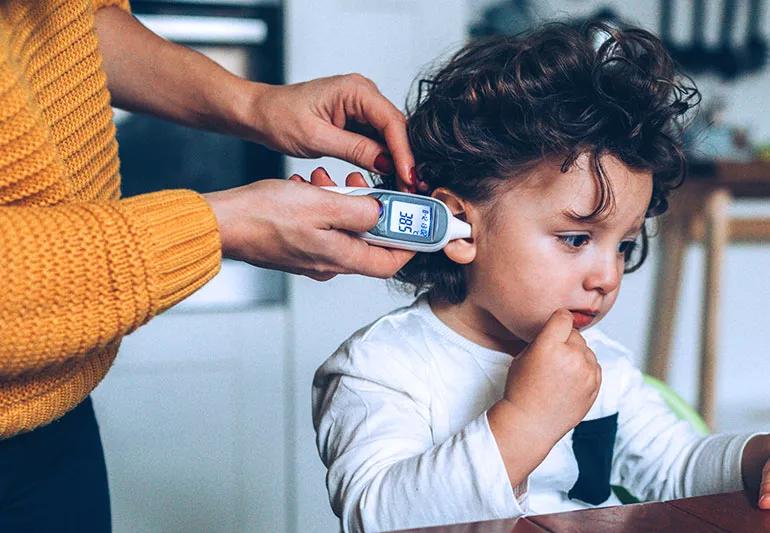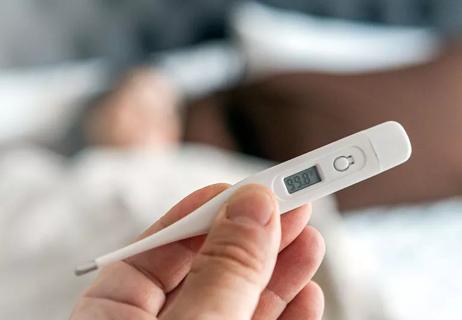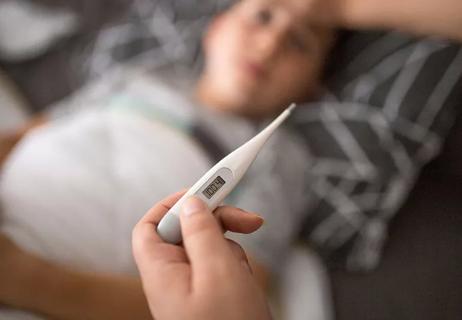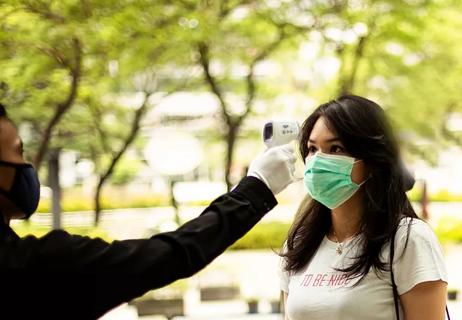You can use a digital, tympanic or temporal artery thermometer

Growing up, your parent may have kissed or placed their hand on your forehead to see if you had a fever. While those gestures may have been endearing and comforting, they weren’t very accurate or scientific. (Sorry, mom and dad.)
Advertisement
Cleveland Clinic is a non-profit academic medical center. Advertising on our site helps support our mission. We do not endorse non-Cleveland Clinic products or services. Policy
That’s why a thermometer — whether it’s a digital thermometer or a tympanic thermometer — has been the go-to way to know if you or your loved ones have a fever. Checking your body’s temperature with a thermometer is an easy and accurate method to see if a fever is present.
A fever, which is a rise in your body’s temperature, is usually caused by an infection. Though fevers can be uncomfortable, they’re a sign that the body is fighting off infection.
Internist Daniel Sullivan, MD, explains how to take a temperature, the different thermometer options and how to clean one.
So, what should your temperature be?
A normal body temperature is about 98.6 degrees Fahrenheit or 37 degrees Celsius. A normal temperature often varies from 1 to 2 F (.5 to 1 C).
“A normal temperature is usually lower in the morning and increases during the day,” explains Dr. Sullivan. “It reaches its high in the late afternoon or evening.”
In adults, a fever is considered to be a temperature of 100.4 F (38 C) or above.
“You can treat this at home with a fever reducer medication and fluids to make yourself more comfortable, or let it run its course,” says Dr. Sullivan.
But if your fever reaches 102 F (38.8 C) or higher and home treatment doesn’t lower it, it’s time to call a healthcare provider.
Advertisement
For kids, a fever is when their temperature is higher than 100.4 F (measured rectally), 99.5 F (measured orally) or 99 F (measured under their arm). If their fever last more than five days or is higher than 104 F (40 C), call their healthcare provider.
When using any kind of thermometer, make sure you read and follow the instructions that come with it.
“If your thermometer uses batteries, check them,” advises Dr. Sullivan. “You might notice that weak batteries give inconsistent readings.”
There are many different types of thermometers you can use to measure temperature such as:
Some thermometers aren’t recommended due to their inaccuracy:
“The main reason mercury glass thermometers aren’t recommended is that mercury can poison you,” explains Dr. Sullivan. “This can happen when the glass breaks and mercury is released. If you do still have one of these thermometers, you should contact your local waste department and find out how to dispose of hazardous waste properly.”
Want to make sure you’re taking a temperature the right way? Dr. Sullivan recommends the following:
Before you use a thermometer, you want to make sure you wash your hands with soap and warm water.
If you’re using a digital oral thermometer, make sure it’s been cleaned in cold water or by using rubbing alcohol, then rinsed in cold water. A digital rectal thermometer should be cleaned in soap and warm water.
When using a digital oral thermometer, you want to place it under the tongue. Keep your mouth closed and keep the thermometer in place for about 40 seconds. Usually, the thermometer will make a beeping noise when the final reading is done. If you’re keeping track, record the temperature and the time.
Advertisement
“Do not eat or drink anything for at least five minutes before you take your temperature because the temperature of the food or beverage could make the reading inaccurate,” notes Dr. Sullivan.
If using a digital rectal thermometer, put a small amount of lubricant (petroleum jelly or Vaseline®) on the sensor (tip) of the thermometer. Then, place your child belly down on your lap or table, with one palm on their back. Or place them face-up, with legs bent toward their chest, and hold the back of their thighs with one hand.
Using your other hand, gently insert the thermometer into their anus until the tip is completely inside their rectum. Don’t force it if you feel resistance. Keep the thermometer steady with your hand until you hear the beep (around 30 seconds). Gently remove the thermometer and record the temperature and time.
Make sure you put a diaper or cloth under your child, as they may poop immediately after removal of the thermometer.
You can also use a digital thermometer to take an axillary temperature. For this method, the thermometer is placed in the armpit of young children or adults whose temperature can’t safely be done orally. This method isn’t as accurate as oral or rectal, but can be used as a quick first check. You can follow this with an oral or rectal reading.
Advertisement
Once done taking a temperature, you need to clean your thermometer again.
Rinse your digital oral thermometer in cold water, clean it with alcohol and rinse again. For a digital rectal thermometer, clean the thermometer thoroughly with soap and water. You may want to clean it again with alcohol and then rinse it again.
If you have questions about how to take a temperature, call your healthcare provider. They can give you tips on what’s the best type of thermometer for your family and the best way to do a temperature check.
This is also a good time to ask things like how often you should recheck temperatures or if you should do anything to try to reduce the fever.
Call your healthcare provider right away if anyone in your household has a fever and any of the following:
Remember, you and your healthcare provider work together to keep you and your family members healthy. They’ll be glad to answer questions about what thermometers are best, how they should be used and which numbers are important to keep track of.
“While a fever may be scary, it’s also trying to tell you something,” affirms Dr. Sullivan. “Your provider is your partner in knowing what is being said and how to respond.”
Advertisement
Learn more about our editorial process.
Advertisement

The not-so-sweet heat could be from a medical condition, menopause or even spicy foods

There’s no one answer, as your temperature fluctuates throughout the day and your life

Use a digital oral, rectal, axillary, ear or forehead thermometer based on your child’s age

Know the risks, the signs and actions you should take

And 4 things you can do to combat heat and cold intolerances

The short answer from a family medicine specialist

If the area is bleeding a lot or the wound is near your face or genitals, you likely need a specialist’s care

Any fever, especially one of 100.5 degrees Fahrenheit or higher, should trigger a call to your oncologist — and maybe a trip to the ER

Babies can get congested easily, but you can calm their cough by keeping them hydrated, using nasal drops and running a humidifier

Weight loss may cause loose, sagging skin and muscle loss to your rear

Several conditions, like vitiligo and fungal infection, can cause a loss of pigmentation, leading to white spots or patches on your skin